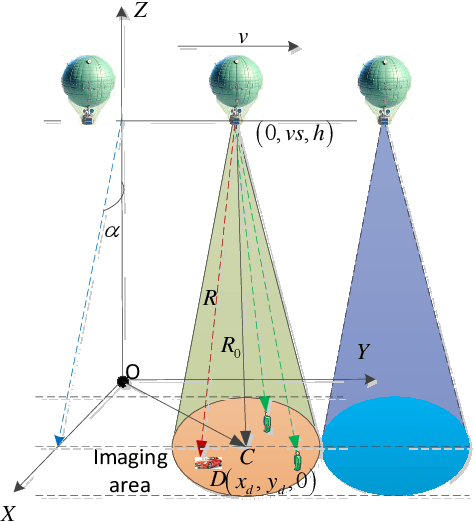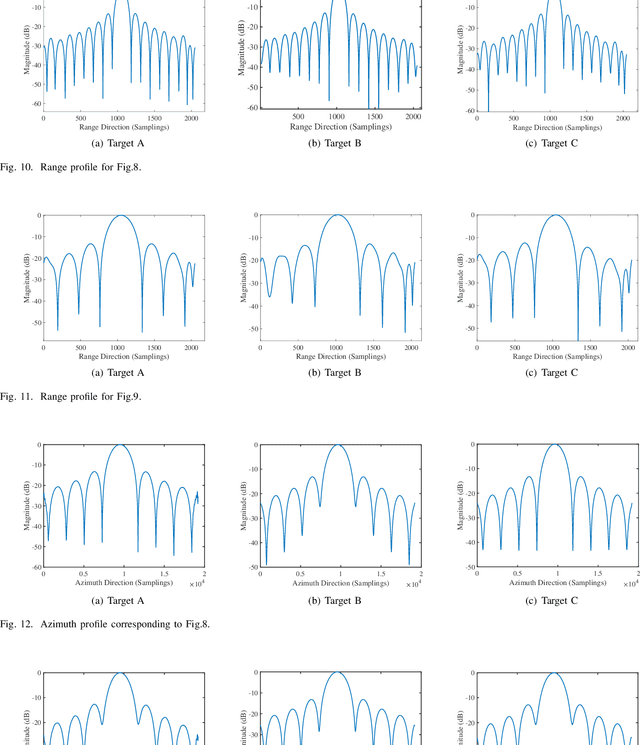Bang Huang
Design of 3D Beamforming and Deployment Strategies for ISAC-based HAPS Systems
Jun 12, 2025Abstract:This paper explores high-altitude platform station (HAPS) systems enabled by integrated sensing and communication (ISAC), in which a HAPS simultaneously transmits communication signals and synthetic aperture radar (SAR) imaging signals to support multi-user communication while performing ground target sensing. Taking into account the operational characteristics of SAR imaging, we consider two HAPS deployment strategies: (i) a quasi-stationary HAPS that remains fixed at an optimized location during SAR operation, following the stop-and-go scanning model; and (ii) a dynamic HAPS that continuously adjusts its flight trajectory along a circular path. For each strategy, we aim at maximizing the weighted sum-rate throughput for communication users while ensuring that SAR imaging requirements, such as beampattern gain and signal-to-noise ratio (SNR), are satisfied. This is achieved by jointly optimizing the HAPS deployment strategy, i.e., its placement or trajectory, along with three-dimensional (3D) transmit beamforming, under practical constraints including transmit power limits, energy consumption, and flight dynamics. Nevertheless, the formulated optimization problems corresponding to the two deployment strategies are inherently non-convex. To address the issue, we propose efficient algorithms that leverage both convex and non-convex optimization techniques to obtain high-quality suboptimal solutions. Numerical results demonstrate the effectiveness and advantages of the proposed approaches over benchmark schemes.
Design of Frequency Index Modulated Waveforms for Integrated SAR and Communication on High-Altitude Platforms (HAPs)
Dec 22, 2024



Abstract:This paper, addressing the integration requirements of radar imaging and communication for High-Altitude Platform Stations (HAPs) platforms, designs a waveform based on linear frequency modulated (LFM) frequency-hopping signals that combines synthetic aperture radar (SAR) and communication functionalities. Specifically, each pulse of an LFM signal is segmented into multiple parts, forming a sequence of sub-pulses. Each sub-pulse can adopt a different carrier frequency, leading to frequency hops between sub-pulses. This design is termed frequency index modulation (FIM), enabling the embedding of communication information into different carrier frequencies for transmission. To further enhance the data transmission rate at the communication end, this paper incorporates quadrature amplitude modulation (QAM) into waveform design. %For the SAR portion, this approach reduces the ADC sampling requirements while maintaining range resolution. The paper derives the ambiguity function of the proposed waveform and analyzes its Doppler and range resolution, establishing upper and lower bounds for the range resolution. In processing SAR signals, the receiver first removes QAM symbols, and to address phase discontinuities between sub-pulses, a phase compensation algorithm is proposed to achieve coherent processing. For the communication receiver, the user first performs de-chirp processing and then demodulates QAM symbols and FIM index symbols using a two-step maximum likelihood (ML) algorithm. Numerical simulations further confirm the theoretical validity of the proposed approach.
Generalized code index modulation-aided frequency offset realign multiple-antenna spatial modulation approach for next-generation green communication systems
Aug 16, 2024Abstract:For next-generation green communication systems, this article proposes an innovative communication system based on frequency-diverse array-multiple-input multiple-output (FDA-MIMO) technology, which aims to achieve high data rates while maintaining low power consumption. This system utilizes frequency offset index realign modulation, multiple-antenna spatial index modulation, and spreading code index modulation techniques. In the proposed generalized code index modulation-aided frequency offset realign multiple-antenna spatial modulation (GCIM-FORMASM) system, the coming bits are divided into five parts: spatial modulation bits by activating multiple transmit antennas, frequency offset index bits of the FDA antennas, including frequency offset combination bits and frequency offset realign bits, spreading code index modulation bits, and modulated symbol bits. Subsequently, this paper utilizes the orthogonal waveforms transmitted by the FDA to design the corresponding transmitter and receiver structures and provide specific expressions for the received signals. Meanwhile, to reduce the decoding complexity of the maximum likelihood (ML) algorithm, we propose a three-stage despreading-based low complexity (DBLC) algorithm leveraging the orthogonality of the spreading codes. Additionally, a closed-form expression for the upper bound of the average bit error probability (ABEP) of the DBLC algorithm has been derived. Analyzing metrics such as energy efficiency and data rate shows that the proposed system features low power consumption and high data transmission rates, which aligns better with the concept of future green communications. The effectiveness of our proposed methods has been validated through comprehensive numerical results.
Adaptive Target Detection for FDA-MIMO Radar with Training Data in Gaussian noise
Mar 21, 2024



Abstract:This paper addresses the problem of detecting a moving target embedded in Gaussian noise with an unknown covariance matrix for frequency diverse array multiple-input multiple-output (FDA-MIMO) radar. To end it, assume that obtaining a set of training data is available. Moreover, we propose three adaptive detectors in accordance with the one-step generalized likelihood ratio test (GLRT), two-step GLRT, and Rao criteria, namely OGLRT, TGLRT, and Rao. The LH adaptive matched filter (LHAMF) detector is also introduced when decomposing the Rao test. Next, all provided detectors have constant false alarm rate (CFAR) properties against the covariance matrix. Besides, the closed-form expressions for false alarm probability (PFA) and detection probability (PD) are derived. Finally, this paper substantiates the correctness of the aforementioned algorithms through numerical simulations.
FDA-MIMO-based Integrated Sensing and Communication System with Frequency Offset Permutation Index Modulation
Dec 22, 2023



Abstract:Considering that frequency diverse array multiple-input multiple-output (FDA-MIMO) possesses extra range information to enhance sensing performance, this paper explores the FDA-MIMO-based integrated sensing and communication (ISAC) system. To reinforce the system communication capability, we propose the frequency offset permutation index modulation (FOPIM) scheme, which conveys extra information bits by selecting and permutating frequency offsets from a frequency offsets pool. For the system communication sub-functionality, considering the fact that the traditional maximum likelihood detection method suffers from high complexity and bit error rate (BER), the maximum likelihood-based two-stage detection (MLTSD) approach is presented to overcome this issue. For the system sensing sub-function, we employ the two-step maximum likelihood estimator (TSMLE) to stepwise estimate the angle and range of the interested target. Furthermore, we derive the closed-form expressions for the tight upper bound on the communication BER, along with the sensing Cram\'er-Rao bound (CRB). The simulation results validate the theoretical analysis, demonstrating that the proposed system exhibits lower BER and superior range resolution than independent MIMO communication and MIMO sensing modules.
Toward Reproducing Network Research Results Using Large Language Models
Sep 09, 2023



Abstract:Reproducing research results in the networking community is important for both academia and industry. The current best practice typically resorts to three approaches: (1) looking for publicly available prototypes; (2) contacting the authors to get a private prototype; and (3) manually implementing a prototype following the description of the publication. However, most published network research does not have public prototypes and private prototypes are hard to get. As such, most reproducing efforts are spent on manual implementation based on the publications, which is both time and labor consuming and error-prone. In this paper, we boldly propose reproducing network research results using the emerging large language models (LLMs). In particular, we first prove its feasibility with a small-scale experiment, in which four students with essential networking knowledge each reproduces a different networking system published in prominent conferences and journals by prompt engineering ChatGPT. We report the experiment's observations and lessons and discuss future open research questions of this proposal. This work raises no ethical issue.
 Add to Chrome
Add to Chrome Add to Firefox
Add to Firefox Add to Edge
Add to Edge